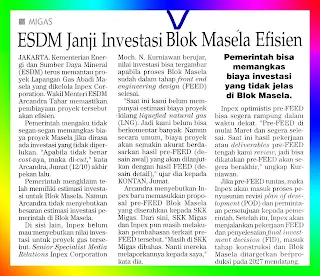The government only sets the winner in one block from the auction of 19 exploration oil and gas blocks
The interest of oil and gas entrepreneurs to invest in exploration blocks is relatively low. The indication is that from the 19 exploration blocks that were auctioned so far this year, the government only decided on the winner for an exploration oil and gas block. The winner of the exploration block is set at the second phase of the auction, namely the period August 14 to October 13, 2018.
In this period, the Ministry of Energy and Mineral Resources (ESDM) actually auctioned six oil and gas blocks, including three termination blocks (production) and three exploration blocks. From the auction, the government assigns winners in four blocks, each of which is three production blocks and one exploration block. The Ministry of Energy and Mineral Resources has not been able to identify the auction winner.
"All termination blocks are in demand," said the Director General of Oil and Gas at the Ministry of Energy and Mineral Resources, Djoko Siswanto, after a hearing with Commission VII of the House of Representatives (DPR).
The best-selling termination oil and gas blocks are the Long Strait Block, South Jambi B Block and Makassar Strait Block. So, only one exploration oil and gas block is sold in the second phase of the auction. Djoko stressed that the two exploration blocks that have not been sold do not mean investors are not interested.
"The exploration block is not unsold. Actually it is in demand and there are those who are interested," he added.
Throughout this year, the government has auctioned 19 exploration and oil and gas blocks on a regular basis. From the results of the first phase of the auction, all exploration oil and gas blocks have not been sold, so the Ministry of Energy and Mineral Resources has re-opened the second phase of the auction. At this auction, the government only offered three exploration oil and gas blocks. From the auction results, only one exploration block is sold.
In the near future, the Ministry of Energy and Mineral Resources will officially announce the winner of the second phase of the oil and gas block auction. The government still has time to announce the second phase of the oil and gas block until October 25, 2018. The government will continue to evaluate the exploration block that has not been sold.
Head of SKK Migas, Amien Sunaryadi also assessed that exploration is very important to increase Indonesia's oil and gas reserves. Currently there are 224 oil and gas blocks in the country. Of that number, only 74 blocks have been produced and the majority are old-age blocks.
"This illustrates the trend of oil and gas lifting is decreasing, while the trend of production costs (Cost recovery) has not decreased. Indonesia must prioritize exploration," said Amien.
IN INDONESIAN
Blok Migas Eksplorasi Masih Sepi Peminat
Pemerintah hanya menetapkan pemenang di satu blok dari lelang 19 blok migas eksplorasi
Minat para pengusaha migas untuk berinvestasi di blok eksplorasi terbilang rendah. Indikasinya, dari 19 blok eksplorasi yang dilelang sepanjang tahun ini, pemerintah hanya memutuskan pemenang untuk satu blok migas eksplorasi. Pemenang blok eksplorasi ditetapkan pada lelang tahap kedua, yakni periode 14 Agustus hingga 13 Oktober 2018.
Di periode ini, Kementerian Energi dan Sumber Daya Mineral (ESDM) sebenarnya melelang enam blok migas, meliputi tiga blok terminasi (produksi) dan tiga blok eksplorasi. Dari lelang itu, pemerintah menetapkan pemenang di empat blok, masing-masing tiga blok produksi dan satu blok eksplorasi. Kementerian ESDM belum bisa menyebutkan identitas pemenang lelang.
"Blok terminasi diminati semua," kata Direktur Jenderal Minyak dan Gas Bumi Kementerian ESDM Djoko Siswanto usai Rapat Dengar Pendapat dengan Komisi VII Dewan Perwakilan Rakyat (DPR).
Adapun blok migas terminasi yang laris adalah Blok Selat Panjang, Blok South Jambi B dan Blok Makassar Strait. Jadi, hanya satu blok migas eksplorasi yang laku dalam lelang tahap kedua. Djoko menegaskan dua blok eksplorasi yang belum laku bukan berarti tidak diminati investor.
"Blok eksplorasi bukan tidak laku. Sebenarnya memang diminati dan ada yang tertarik," tambahnya.
Sepanjang tahun ini, pemerintah telah melelang 19 blok migas eksplorasi secara reguler. Dari hasil lelang tahap pertama, seluruh blok migas eksplorasi belum laku sehingga Kementerian ESDM kembali membuka lelang tahap kedua. Di lelang ini, pemerintah hanya menawarkan tiga blok migas eksplorasi. Dari hasil lelang itu, hanya satu blok eksplorasi yang laku.
Dalam waktu dekat, Kementerian ESDM akan mengumumkan secara resmi pemenang lelang blok migas tahap kedua. Pemerintah masih punya waktu mengumumkan Ielang blok migas tahap kedua hingga 25 Oktober 2018. Pemerintah akan terus mengevaluasi blok eksplorasi yang belum laku.
Kepala SKK Migas, Amien Sunaryadi juga menilai eksplorasi sangat penting untuk menambah cadangan migas Indonesia. Saat ini terdapat 224 blok migas di Tanah Air. Dari jumlah itu, hanya 74 blok yang sudah berproduksi dan mayoritas merupakan blok yang berumur tua.
"Ini menggambarkan tren lifting migas menurun, sedangkan tren biaya produksi (Cost recovery) tidak menurun. Indonesia harus memprioritaskan eksplorasi,“ kata Amien.
Kontan, Page-14, Tuesday, Oct 16, 2018






















